Ch. 23 - Carbohydrate Metabolism
1/38
There's no tags or description
Looks like no tags are added yet.
Name | Mastery | Learn | Test | Matching | Spaced |
|---|
No study sessions yet.
39 Terms
Digestion of Carbohydrates
During carbohydrate digestion, di- and polysaccharides are hydrolyzed to monosaccharides
After digestion, glucose, fructose, and galactose are absorbed into the bloodstream through the lining of the small intestine and transported to the liver
In the liver, fructose and galactose are converted to glucose or metabolically similar compounds
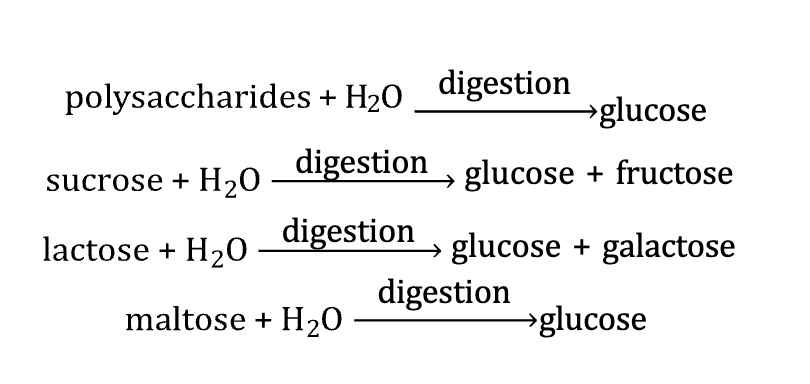
Blood Glucose
Liver regulates the blood glucose level
liver responds to increase in blood glucose after a meal by removing glucose from bloodstream
Converts the removed glucose to glycogen or triglycerides
Converts glycogen to glucose and synthesizes new glucose from noncarbohydrate substances when blood glucose levels are low
Blood Sugar Level
Amount of glucose present in blood
expressed as mg glucose per 100 mL of blood
Highest about 1 hour after a carb-containing meal
Returns to normal after 2 to 2.5 hours
Hypoglycemia
Lower-than-normal blood sugar level
Hyperglycemia
Higher-than-normal blood sugar level
Renal Threshold
Blood sugar level at which sugar is not completely reabsorbed by the kidneys
point at which glucose can be detected in urine
Glucosuria
Condition where elevated blood sugar levels result in the excretion of glucose in the urine
Prolonged hyperglycemia at glucosuric levels is considered serious
Normal Fasting Level
70-110 mg/100 mL
Glycolysis
Glucose is catabolically oxidized through a series of steps to pyruvate
Occurs in the cellular cytoplasm
Net reaction
glucose + 2P i + 2ADP + 2NAD+ → 2Pyruvate + 2ATP + 2NADH + 4H + + 2H2O
Regulation of Glycolysis
regulated by hexokinase, phosphofructokinase, and pyruvate kinase
As glycolysis occurs, the citric acid cycle and electron transport chain produce large quantities of ATP
If the ATP level is low, then AMP and ADP levels are high
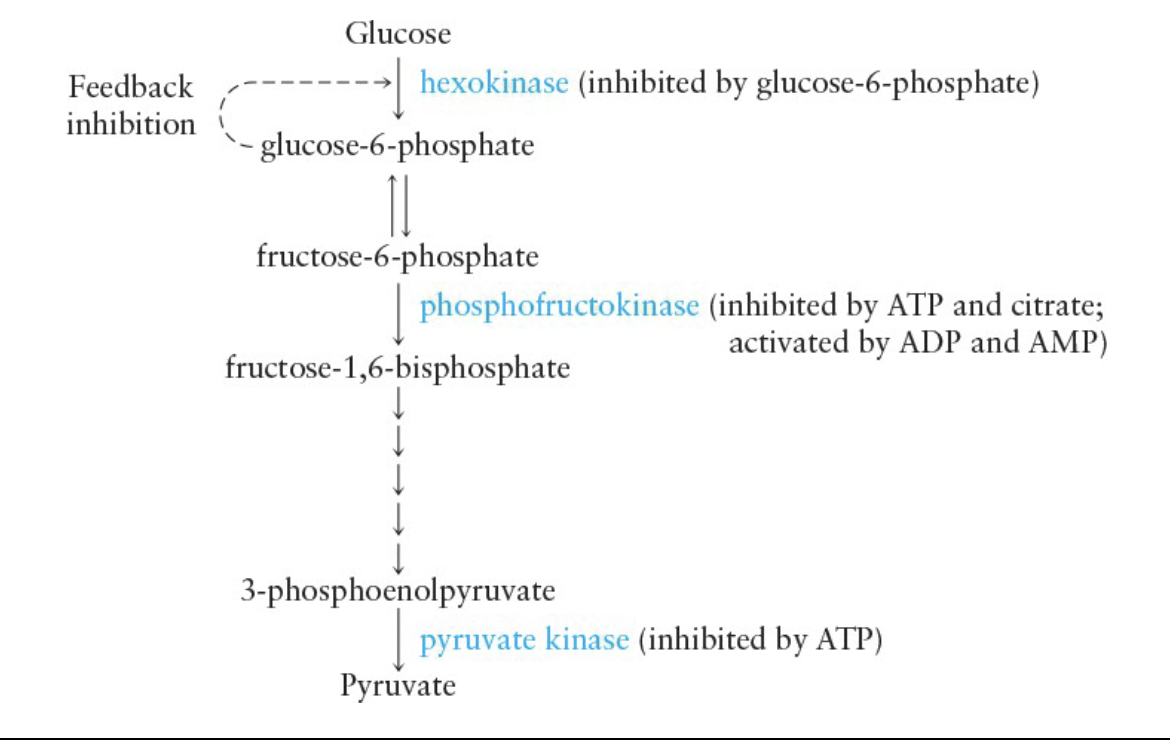
What inhibits hexokinase?
Glucose-6-phosphate noncompetitively inhibits hexokinase
this is a feedback inhibition
What inhibits and what activates phosphofructokinase?
inhibited by high concentrations of ATP and citrate
Activated by high concentrations of ADP and AMP
What inhibits pyruvate kinase?
inhibited by high concentrations of ATP
Fates of Pyruvate
After glycolysis, pyruvate can be:
Oxidized to acetyl CoA
Reduced to lactate
Reduced to ethanol
All processes must regenerate NAD+ from NADH so that glycolysis can continue

Oxidation of Pyruvate to Acetyl CoA
Occurs in the mitochondria under aerobic conditions
Most of the acetyl CoA will be completely oxidized to CO2 in the CAC
NAD+ is regenerated when NADH transfers its electrons to O2 in the ETC
Some acetyl CoA will serve as starting material for fatty acid biosynthesis

Reduction of Pyruvate to Lactate
Occurs in cells after strenuous or long-term muscle activity because the supply of oxygen is not enough for the reoxidation of NADH to NAD+
Under anaerobic conditions, animals and some microorganisms can obtain limited energy through lactate formation

Reduction of Pyruvate to Ethanol
Under anaerobic conditions, some microorganisms can obtain limited energy through glycolysis
Alcoholic fermentation: Conversion of glucose to ethanol
Only occurs in prokaryotes, not humans

Citric Acid Cycle (CAC)
Series of reactions in which acetyl CoA is oxidized to CO2 and FADH2 and NADH are formed
Principal process for generating NADH and FADH2
Source of materials for biosynthesis
Occurs within the matrix of the mitochondrion

Features of the CAC
Fueled by acetyl CoA
Operation of the cycle depends on reactions of the ETC for the supply of NAD+ and FAD+
2 carbon atoms enter the cycle as an acetyl unit and 2 carbon atoms leave the cycle as 2 molecules of CO2
There is a one-cycle delay between the entry and exit of the atoms
4 oxidation–reduction reactions produce 3 NADH and 1 FADH2 in one complete cycle
1 guanosine triphosphate (GTP) is produced
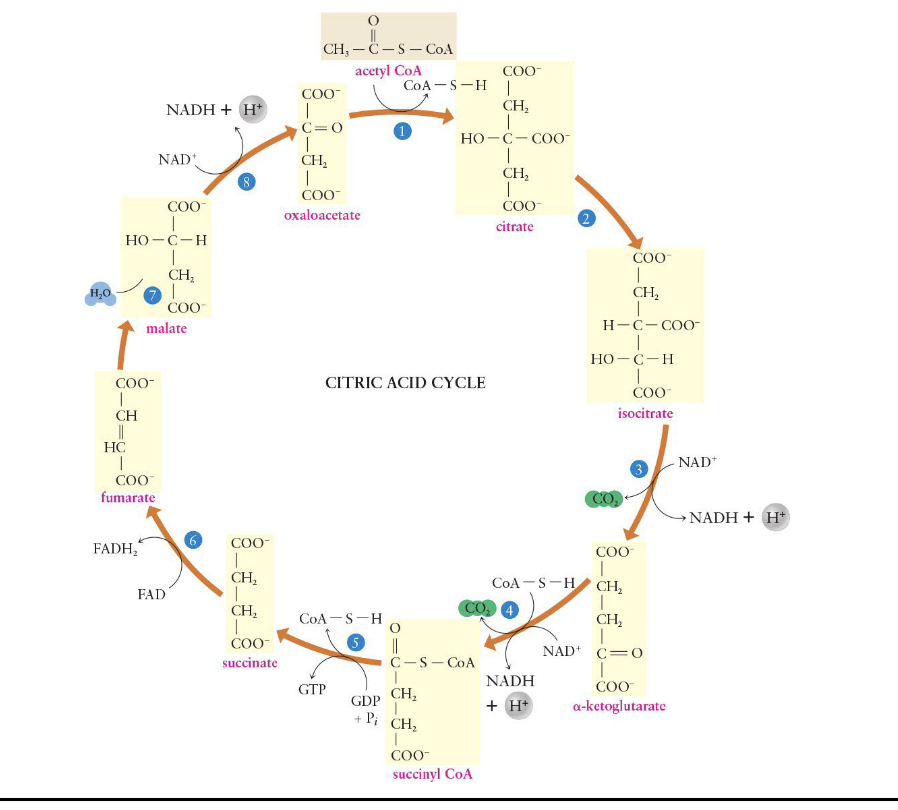
Regulation of Citric Acid Cycle
Entry of acetyl CoA and rate of operation of the cycle are:
Reduced when cellular ATP levels are high
Stimulated when ATP supplies are low and ADP levels are high
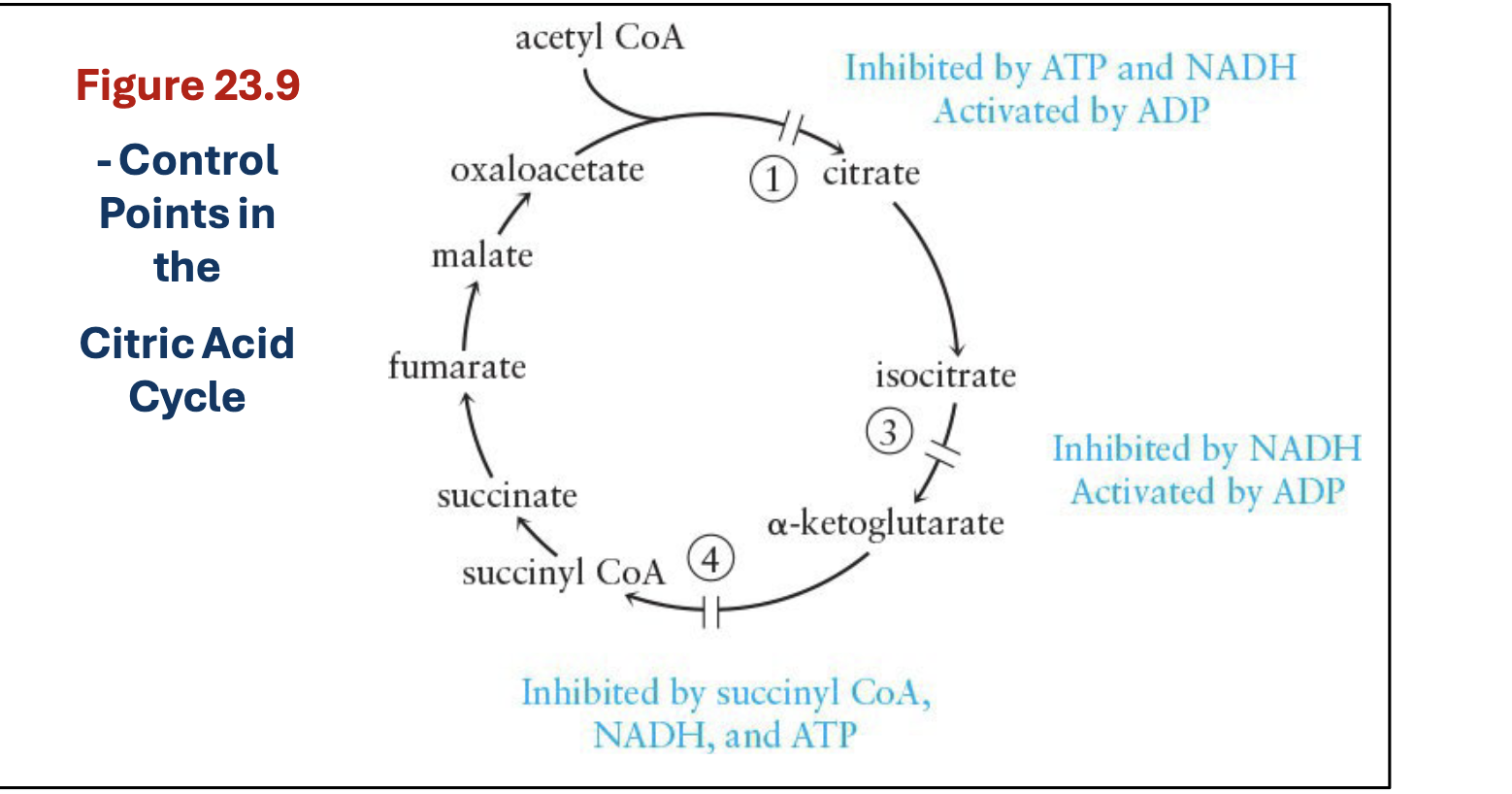
Control Points in the CAC
Point 1
Inhibited by ATP and NADH
Activated by ADP
Point 2
Inhibited by NADH
Activated by ADP
Point 3
Inhibited by succinyl CoA, NADH, and ATP
What compound is the starting compound AND ending compound in the CAC?
Oxaloacetate
Electron Transport Chain (ETC)
Series of reactions where protons and electrons from the oxidation of foods are used to reduce molecular oxygen to water
NADH and FADH2 are produced by the citric acid cycle
Carry hydrogen ions and electrons during food oxidation
Net equation
4H+ + 4e - + O2 → 2H2O
Electron carriers are lined up in order of increasing affinity for electrons
First electron carrier is flavin mononucleotide (FMN)
Contains a tightly bound coenzyme, which has a structure similar to FAD
Four electron carriers are cytochromes

Cytochromes
iron-containing enzymes
Oxidative Phosphorylation
Process coupled with the ETC whereby ADP is converted to ATP
Helps conserve some free energy
a lot of free energy is released as electrons are transported along the ETC
Oxidation and phosphorylation reactions conserve approximately:
34% of the energy released from the electron transport chain for each mole of NADH
25% of the energy released from the electron transport chain for each mole of FADH2
Energy yield for the entire catabolic pathway:
(citric acid cycle, electron transport chain, and oxidative phosphorylation combined)
3 NADH produces 7.5 ATP
1 FADH 2 produces 1.5 ATP
1 GTP is equivalent to 1 ATP
10 ATP total produced
Chemiosmotic Hypothesis
States that a proton flow across the inner mitochondrial membrane during the operation of the ETC provides energy for ATP synthesis
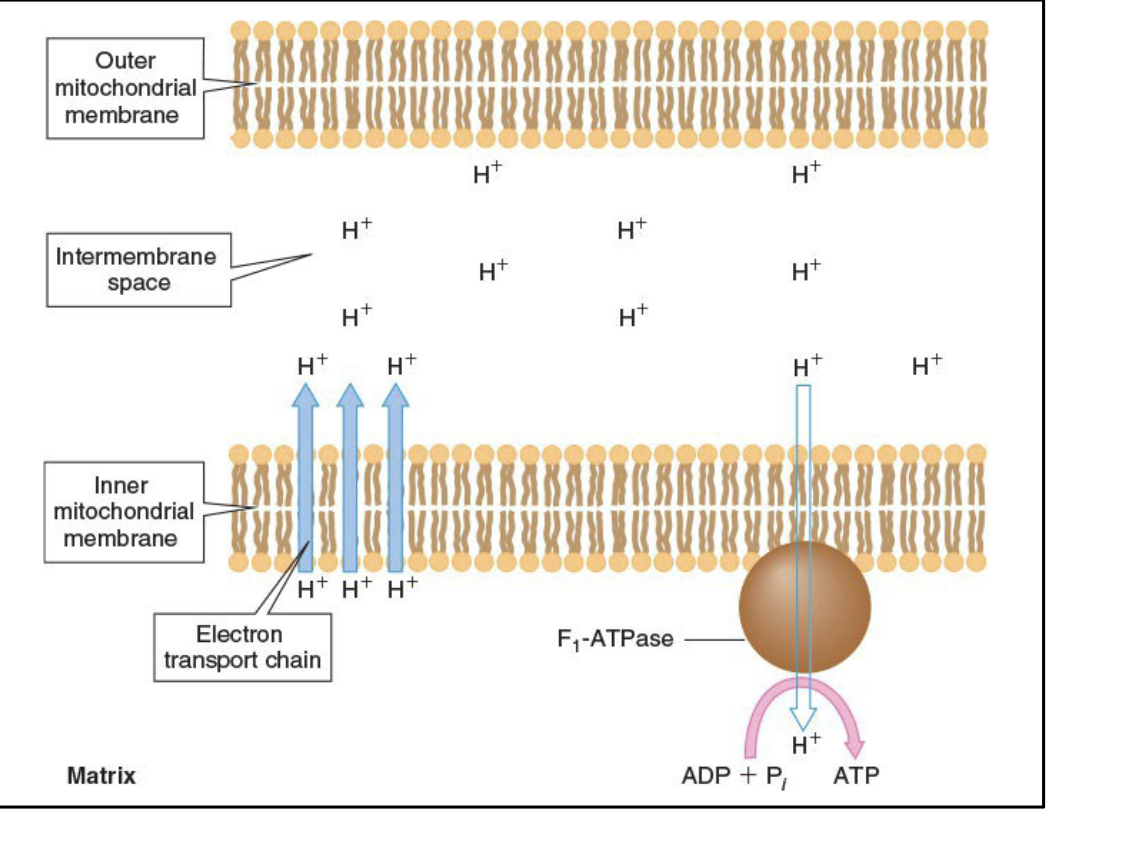
Complete Oxidation of Glucose
Net Yield is 32 ATP
NADH produced in the cytoplasm does not pass through the mitochondrial membrane to the site of the ETC
Brain and muscle cells employ a transport mechanism that passes electrons from cytoplasmic NADH through the membrane to FAD molecules inside mitochondria
One molecule of cytoplasmic NADH generates only 1.5 molecules of ATP
In liver, heart, and kidney, one molecule of mitochondrial NADH and 2.5 molecules ATP are generated for every cytoplasmic NADH
Glycogenesis
Synthesis of glycogen from glucose
Glucose units bond to a growing glycogen chain
Hydrolysis of UTP provides energy
Occurs in all cells but is especially important in liver and muscle cells
Glycogen is mainly stored in liver and muscle tissue
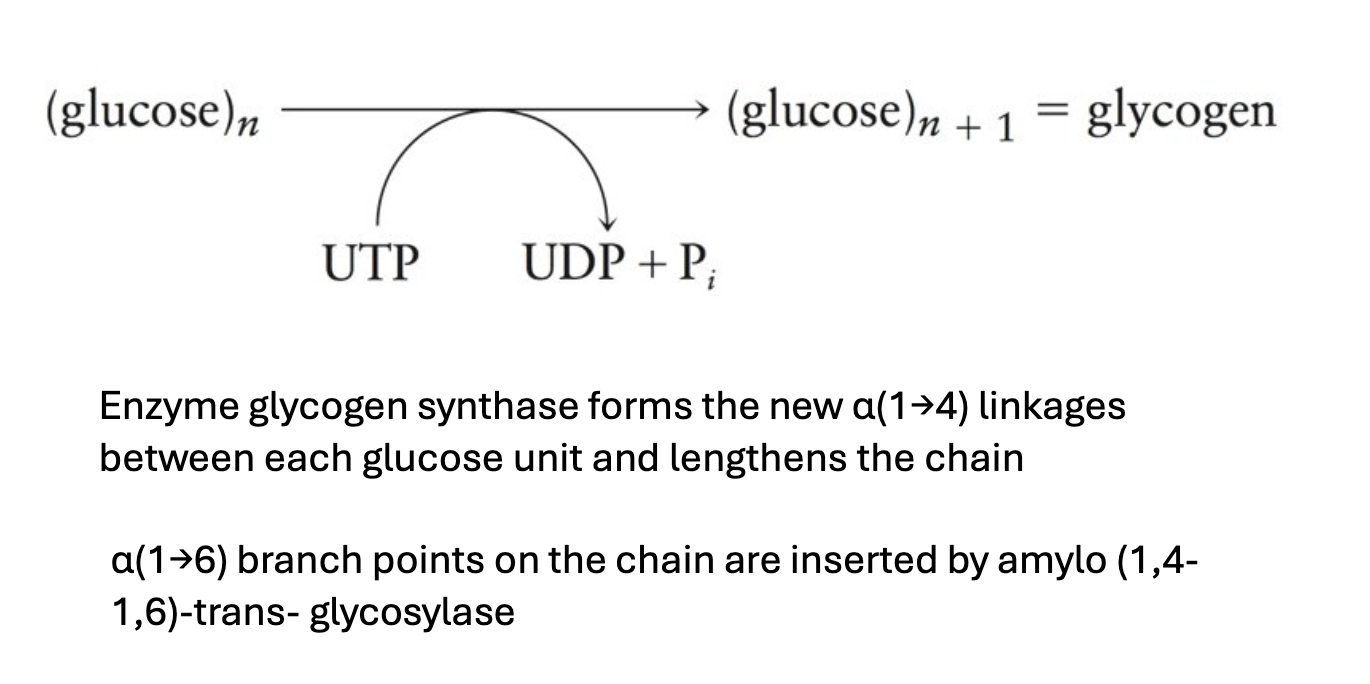
Glycogenolysis
Breakdown of glycogen to glucose
Occurs in the liver, kidney, and intestinal cells but not in the muscle tissue
Muscle cells cannot form free glucose from glycogen
Can carry out the first 2 steps of glycogenolysis to produce glucose-6-phosphate for energy production
Liver
Maintains a relatively constant level of blood glucose
Has the ability to break down glycogen to glucose, which is released into the blood during muscular activity and between meals
Steps of Glycogenolysis
Step 1:
Cleavage of α(1→4) linkages is catalyzed by glycogen phosphorylase
Step 2 - Cleavage of α(1→6) linkages by hydrolysis
Hydrolysis is carried out by a debranching enzyme
Step 3:
Hydrolysis of glucose 6-phosphate
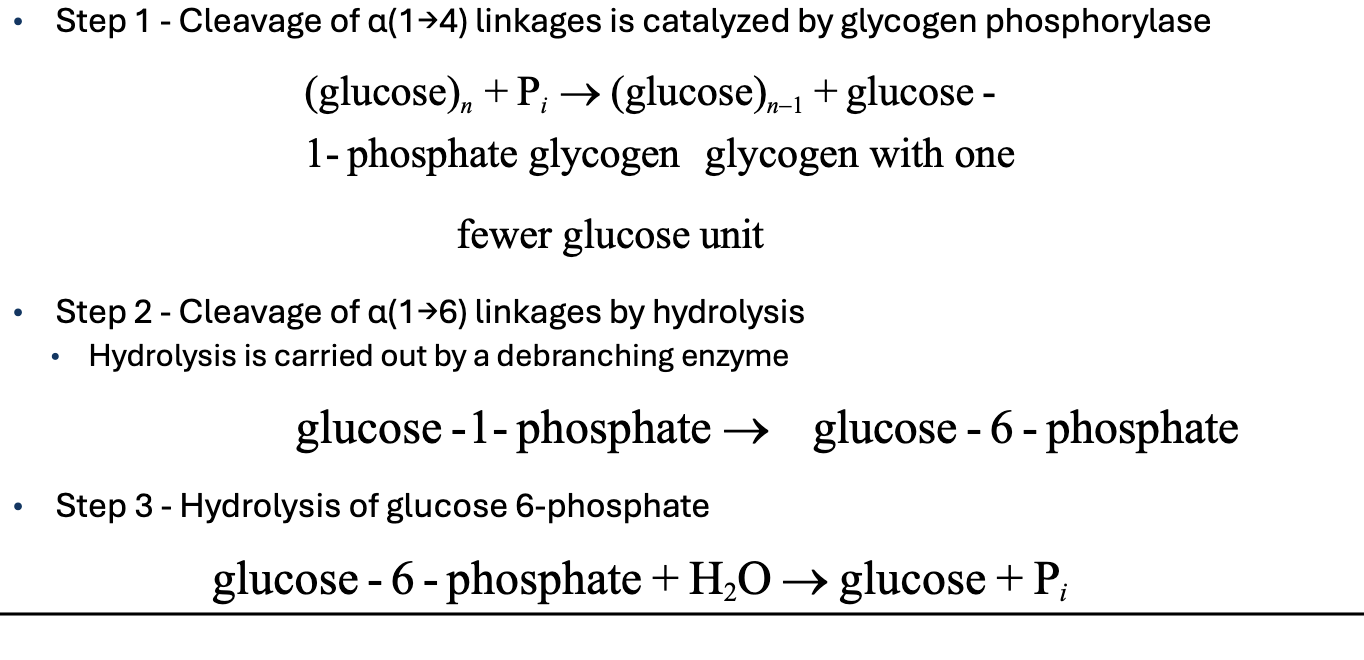
Gluconeogenesis
Synthesis of glucose from noncarbohydrate molecules
(lactate, certain amino acids, glycerol) → pyruvate → glucose
Primarily occurs in the liver (90%)
Helps maintain blood glucose level
Occurs in the kidneys, brain, skeletal muscle, or heart in small amounts
Cori Cycle
Process where glucose is converted to lactate in muscle tissue, lactate is reconverted to glucose in liver, and glucose is returned to the muscle
During active exercise:
Lactate levels increase in muscle tissue and the compound diffuses out of the tissue into the blood
Lactate is taken to liver and converted back to pyruvate
Pyruvate is converted to glucose by gluconeogenesis and glucose enters the blood and returns to the muscles
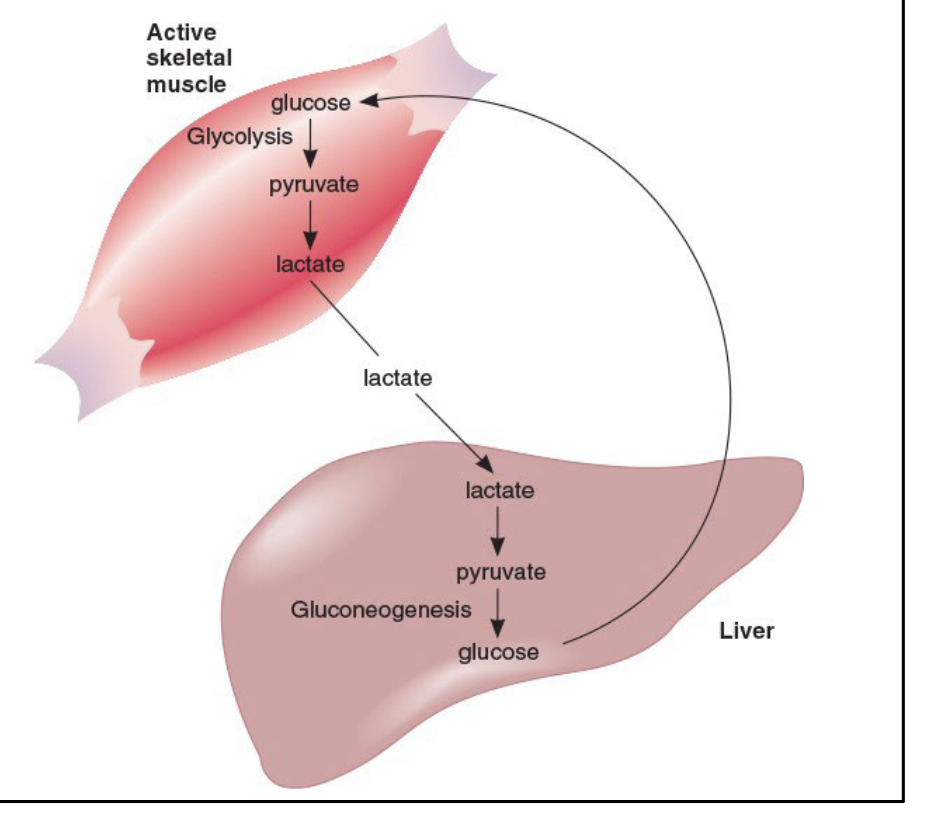
Hormones that Control Carbohydrate Metabolism
Insulin
Glucagon
Epinephrine
Insulin in Carbohydrate Metabolism
Source - β-cells of pancreas
Enhances the absorption of glucose from the blood into the cells of active tissue
Increases the rate of synthesis of glycogen, fatty acids, and proteins
stimulates glycolysis
lowers blood glucose levels
Glucagon in Carbohydrate Metabolism
Source - α-cells of pancreas
Increases blood glucose levels
Activates the breakdown of glycogen in the liver
Epinephrine in Carbohydrate Metabolism
Source - Adrenal medulla
increases blood glucose levels
stimulates glycogen breakdown in muscles and liver
What does blood sugar level depend on?
it depends on the biochemical balance of insulin and glucagon
this can be influenced by growth hormones and adrenal cortex steroids